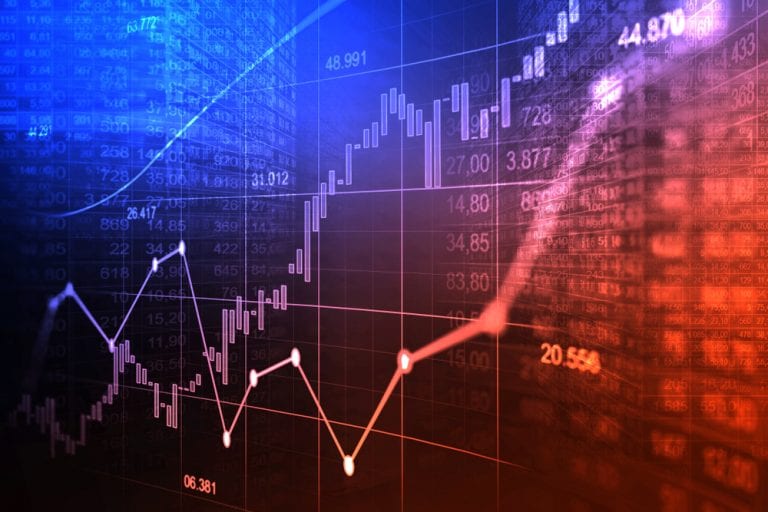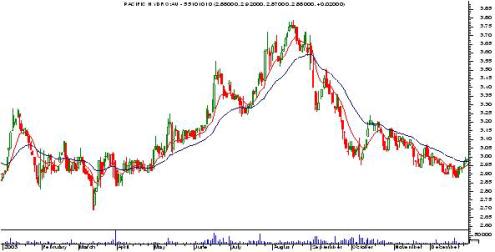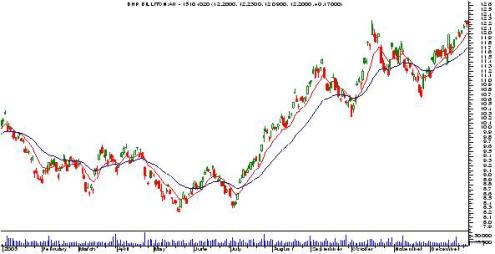
The age old battle of Trading Vs Investing and which method is best to ensure your money is working the hardest for you. There is a saying that time in the market is more important than timing the market. This article looks at some simple trading ideas and compares it against a buy and hold investing strategy with ASX stock examples. The shares below have been chosen for demonstration purposes and do not reflect the returns that an investor will achieve when investing in the share market. It is possible for a trader or investor to make consecutive losses and if trading CFDs, it is possible to lose more than what you start with.
Can a Simple Moving Average System Win?
The system used to buy and sell shares is a very simple system buying the share when a 10 day moving average (red line) crosses up through a 30 day moving average (blue line) and selling when it crosses down.
The time period being considered is 2003 during which time the whole market rose by 9.7%.
CBA Investing example
- Buy at $27.10
- Sell at $29.45
- Total profit $2.35 or 8.67%
CBA Trading example
Trade 1
- Buy at $27.70
- Sell at $27.41
- Total loss -$0.29
Trade 2
- Buy at $25.58
- Sell at $28.70
- Total profit $3.12
Trade 3
- Buy at $27.98
- Sell at $27.56
- Total loss -$0.42
Trade 4
- Buy at $28.11
- Sell at $29.45
- Total profit $1.34
Total Trading profit $3.75 or 13.5%
From studying CBA (above) and PHY (below) trading outperformed investing by getting you out of a share that is going down and keeping you in the share as it goes up.

PHY Investing example
- Buy at $2.90
- Sell at $2.98
- Total profit $0.08 or 2.76%
PHY Trading example
Trade 1
- Buy at $3.05
- Sell at $2.95
- Total loss -$0.10
Trade 2
- Buy at $3.00
- Sell at $2.92
- Total loss $0.08
Trade 3
- Buy at $2.96
- Sell at $2.92
- Total loss -$0.04
Trade 4
- Buy at $2.91
- Sell at $3.38
- Total profit $0.47
Total Trading profit $0.25 or 8.20%
So in these two examples of trading versus investing, you can see that trading has the upper hand. Unfortunately it is not as clear cut as that as there are many examples of when investing would have led to a greater benefit. Below is an example of that.

BHP Investing Example
- Buy at $10.15
- Sell at $12.19
- Total profit $2.04 or 20.10%
BHP Trading Example
Trade 1
- Buy at $9.60
- Sell at $8.99
- Total loss -$0.61
Trade 2
- Buy at $9.02
- Sell at $8.66
- Total loss -$0.36
Trade 3
- Buy at $10.49
- Sell at $10.91
- Total profit $1.53
Trade 4
- Buy at $10.91
- Sell at $11.10
- Total profit $0.19
Trade 5
- Buy at $11.38
- Sell at $12.19
- Total profit $0.81
Total Trading profit $1.56 or 16.25%
In BHP this simple trading system under performed a buy and hold approach.
So at first glance trading a share seems to be a more rewarding way to get results from the market, but as you can see, our sample size is very small (3 share examples).
A reliable trading strategy that accurately defines when to buy a share and when to sell the same share can sometimes achieve a superior performance to the straightforward buy and hold strategy. If it’s this simple then why isn’t everyone actively trading the markets. There are some other things to consider when actively trading the market.
Do you have a well developed trading plan?
The first and most important is to develop a reliable and profitable strategy for trading. Many traders do not have the knowledge or haven’t spent the time developing a system that will consistently outperform the market.
These traders are destined to fail in the markets simply because their strategy does not work. In this case the traders seeking higher returns can often end up in a worse position than if they simply bought a share and held on to the share for the same period of time.
What's the difference between theory and actual results?
The second is implementing the trading system to achieve the results that can be achieved in theory. When the shares are actually bought and sold, there may be a difference between the price you want to pay for the share and the price you do pay for the share.
Following the system above states buy ANN at 5.91. When it comes time to buy ANN the trader may end up paying 5.93 for the share. This is known as slippage. For the investor it makes very little difference as his or her transactions are very infrequent, maybe once every 2 – 3 years.
For the trader this difference can be significant reducing the advantage over a buy and hold strategy, especially if the strategy requires frequent trades to achieve the results.
What impact does brokerage play in the overall results?
Another factor that needs to be taken into account is brokerage. An active trader will pay more to their broker as they trade more frequently than an investor. The impact of brokerage and commissions becomes more important to the active trader and discounted brokers on the internet are often chosen for this reason.
It goes without saying that CFD brokers have significantly reduced the cost of buying and selling Australian Stocks so brokerage no longer plays as critical a role in your overall result.
Do not let low cost brokerage make all your decisions. Buying BHP instead of ANN above would make far more difference to your returns than some extra brokerage. If broker’s advice is good they will improve your returns implementing a strategy that will outperform a buy and hold strategy.
Make sure you are well capitalised
The size of your trading account will determine the impact of costs such as brokerage on your returns. Most brokers charge a minimum fee which means a $5000 trade will cost the same as a $20,000 trade. If you were to make 10% on $5000, you have made $500 profit.
If this costs $100 brokerage then you keep $400 profit. If you were to make the same return on $20,000 you have made $2000 profit, less $100 brokerage means a return of $1900. In these examples; brokerage on the $5000 trade was 20% of your profit and brokerage on the $20,000 trade was 5% of your profit. This is a significant difference.
The minimum parcel size recommended for active traders would be approximately $5,000 and the suggested minimum portfolio size would be $30,000. This allows the trader to easily cover their brokerage costs and spread their money between more than one share.
The final consideration to take into account is time. Active trading requires a lot more time to implement than a buy and hold approach. The time you have available to focus on your investments will determine your ideal investment strategy.
PEOPLE WHO READ THIS ALSO VIEWED:




